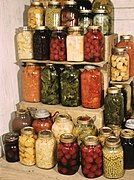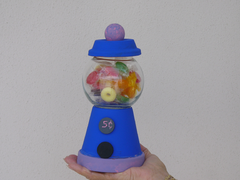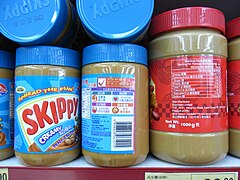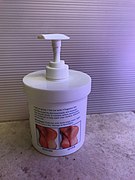Jar: Difference between revisions
No edit summary |
|||
| Line 3: | Line 3: | ||
A '''jar''' is a rigid, cylindrical or slightly conical container, typically made of glass, ceramic, or plastic, with a wide mouth or opening that can be closed with a [[lid]], [[screw cap]], lug cap, cork stopper, roll-on cap, crimp-on cap, press-on cap, [[Shrink wrap|plastic shrink]], heat sealed lidding film, an inner seal, a [[Tamper-evident band]], or other suitable means. |
A '''jar''' is a rigid, cylindrical or slightly conical container, typically made of glass, ceramic, or plastic, with a wide mouth or opening that can be closed with a [[lid]], [[screw cap]], lug cap, cork stopper, roll-on cap, crimp-on cap, press-on cap, [[Shrink wrap|plastic shrink]], heat sealed lidding film, an inner seal, a [[Tamper-evident band]], or other suitable means. |
||
Jars |
Jars can be used to hold solids too large to be removed from, or liquids too viscous to be poured through, a [[bottle]]'s neck; these may be foods, cosmetics, medications, or chemicals. <ref>Yam, K. L., "Encyclopedia of Packaging Technology", John Wiley & Sons, 2009, {{ISBN|978-0-470-08704-6}}</ref> Glass jars—among which the most popular is the [[mason jar]]—can be used for storing and preserving items as diverse as jam, pickled gherkin, other pickles, marmalade, sun-dried tomatoes, olives, jalapeño peppers, chutneys, pickled eggs, honey, and many others. |
||
Jars are [[Sterilization (microbiology)|sterilised]] by putting them in a pressure cooker with boiling water or an oven for a number of minutes. Glass jars are considered microwavable.<ref>{{cite journal |last2=Heiniö |first2=R.-L. |last=Ahvenainen |title=Factors affecting the suitability of glass jars for heating in microwave ovens. Comparison with plastic jars and paper board tubs |journal=Packaging Technology and Science |volume=6 |issue=1 |pages=43–52 |year=1993 |doi=10.1002/pts.2770060108}}</ref> |
Jars are [[Sterilization (microbiology)|sterilised]] by putting them in a pressure cooker with boiling water or an oven for a number of minutes. Glass jars are considered microwavable.<ref>{{cite journal |last2=Heiniö |first2=R.-L. |last=Ahvenainen |title=Factors affecting the suitability of glass jars for heating in microwave ovens. Comparison with plastic jars and paper board tubs |journal=Packaging Technology and Science |volume=6 |issue=1 |pages=43–52 |year=1993 |doi=10.1002/pts.2770060108}}</ref> |
||
| Line 10: | Line 10: | ||
==Gallery== |
==Gallery== |
||
<gallery mode=packed> |
<gallery mode="packed"> |
||
File:PreservedFood1.jpg|Preserved food in [[Mason jar]]s |
File:PreservedFood1.jpg|Preserved food in [[Mason jar]]s |
||
File:Jam jar.jpg|Reusable jam jar with [[flip-top]] or bail closure |
File:Jam jar.jpg|Reusable jam jar with [[flip-top]] or bail closure |
||
Revision as of 09:19, 6 May 2019

A jar is a rigid, cylindrical or slightly conical container, typically made of glass, ceramic, or plastic, with a wide mouth or opening that can be closed with a lid, screw cap, lug cap, cork stopper, roll-on cap, crimp-on cap, press-on cap, plastic shrink, heat sealed lidding film, an inner seal, a Tamper-evident band, or other suitable means.
Jars can be used to hold solids too large to be removed from, or liquids too viscous to be poured through, a bottle's neck; these may be foods, cosmetics, medications, or chemicals. [1] Glass jars—among which the most popular is the mason jar—can be used for storing and preserving items as diverse as jam, pickled gherkin, other pickles, marmalade, sun-dried tomatoes, olives, jalapeño peppers, chutneys, pickled eggs, honey, and many others.
Jars are sterilised by putting them in a pressure cooker with boiling water or an oven for a number of minutes. Glass jars are considered microwavable.[2]
Some regions[In what country?] have a legally mandated deposit refundable upon return of the jar to its retailer, after which the jar is recycled according to the SPI recycling code for the material.[3]
Gallery
-
Preserved food in Mason jars
-
Reusable jam jar with flip-top or bail closure
-
Jar made of PLA-blend bio-flex, a bioplastic
-
Candy jar
-
Peanut butter
-
Six types of "earthenware jar" in Spain
-
Brown-glazed jar with design of three fish. Yuan Dynasty.
-
PP jar of skin cream with pump dispenser
See also
- Amphora
- Bottle
- Canning
- Child-resistant packaging
- Cookie jar
- Jar opener
- Leyden Jar
- Tamper-evident
- Tamper resistant
Rebuttal
References
- ^ Yam, K. L., "Encyclopedia of Packaging Technology", John Wiley & Sons, 2009, ISBN 978-0-470-08704-6
- ^ Ahvenainen; Heiniö, R.-L. (1993). "Factors affecting the suitability of glass jars for heating in microwave ovens. Comparison with plastic jars and paper board tubs". Packaging Technology and Science. 6 (1): 43–52. doi:10.1002/pts.2770060108.
- ^ Soroka, W, "Fundamentals of Packaging Technology", IoPP, 2002, ISBN 1-930268-25-4
External links
 Media related to Jars at Wikimedia Commons
Media related to Jars at Wikimedia Commons- . Encyclopædia Britannica. Vol. 15 (11th ed.). 1911.








